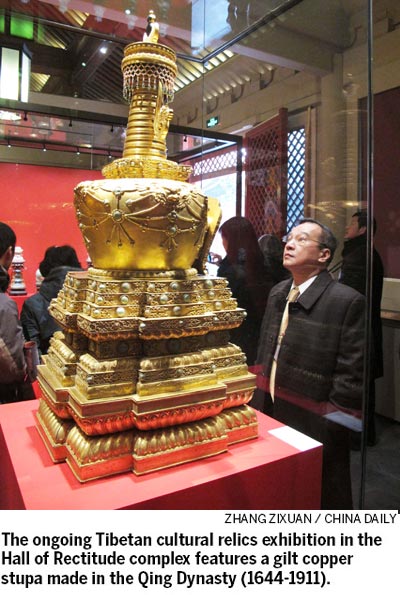Tibetan Buddhist architecture restored to its original glory
Updated: 2012-12-05 10:17
By Zhang Zixuan (China Daily)
|
|||||||||||

The Hall of Rectitude complex, the most concentrated Tibetan Buddhist architecture group within the Forbidden City, has been successfully restored. It was destroyed almost a century ago, during the Qing Dynasty (1644-1911).
Related: China issues special stamps for Confucius Institutes
The six-year restoration project was handled by the Palace Museum and the China Heritage Fund, a Hong Kong-based NGO that preserves and restores cultural relics throughout China.
"The restoration brought back to life an exquisite imperial ground," says Shan Jixiang, director of the Palace Museum. "The blemish from the devastation of the previous century has been removed, making the Forbidden City whole again."
Located at the northwestern part of the Forbidden City and the south of the Garden of the Palace of Established Happiness, the Hall of Rectitude complex is composed of 10 Tibetan Buddhist buildings with the Hall of Rectitude at the center.
"The complex is the only area within the Forbidden City consisting only of Buddhist architecture," says Wang Yuegong, deputy director of the Palace Department and secretary-general of the Tibetan Buddhist Heritage Research Center of the Palace Museum.
It used to serve as the site of Tibetan Buddhist rituals and the storage space for Buddhist cultural relics, such as sutras, statues and thangka. Its function had been augmented since 1697, during Emperor Kangxi's reign, when the Qing court established a specific organization within the Hall of Rectitude to take charge of all Tibetan Buddhist related activities.
Related: Living Buddha sees blessings in earthquake
In 1923, a devastating fire that started in the Garden of the Palace of Established Happiness spread to the complex and destroyed all except the Pavilion of the Rain of Flowers, a section of the Hall of Precious Prosperity and two other smaller structures.
From 2000-05, the Palace Museum and the China Heritage Fund have successfully restored the Garden of the Palace of Established Happiness. In 2006, the two organizations rebuilt the Hall of Rectitude complex based on historical documents, file photos and paintings.
"The China Heritage Fund didn't just invest the money but also considered the project as an inheritance undertaking," says Shan, director of the Palace Museum.
"The destruction of a nation's cultural heritage reflects the country's decline and turmoil. But its restoration is a sure sign of the country's rise and prosperity," echoes Ronnie C. Chan, founding chairman of the China Heritage Fund. "I would be the biggest fool in the world if I didn't do it."
The complex will recover its historic function to serve as the Palace Museum's Tibetan Buddhist Cultural Heritage Research Center and as the exhibiting space for Tibetan Buddhist cultural relics.
An exhibition featuring more than 100 relics is ongoing at the complex to celebrate its completion.
zhangzixuan@chinadaily.com.cn
Related Stories
Classic Chinese opera captivates New Yorklated: 2012-12-04 09:48
China's Bao'an ethnic group famous for broadsword forging technique 2012-12-03 16:14
Renowned sculptor's works in Jingdezhen 2012-12-03 16:01
China issues special stamps for Confucius Institutes 2012-12-03 15:41
People celebrate 100th anniversary of bridge completion in SW China 2012-12-03 15:32
Today's Top News
Rescuers race against time for quake victims
Telecom workers restore links
Coal mine blast kills 18 in Jilin
Intl scholarship puts China on the map
More bird flu patients discharged
Gold loses sheen, but still a safe bet
US 'turns blind eye to human rights'
Telecom workers restore links
Hot Topics
Lunar probe , China growth forecasts, Emission rules get tougher, China seen through 'colored lens', International board,
Editor's Picks

|

|

|

|

|

|





